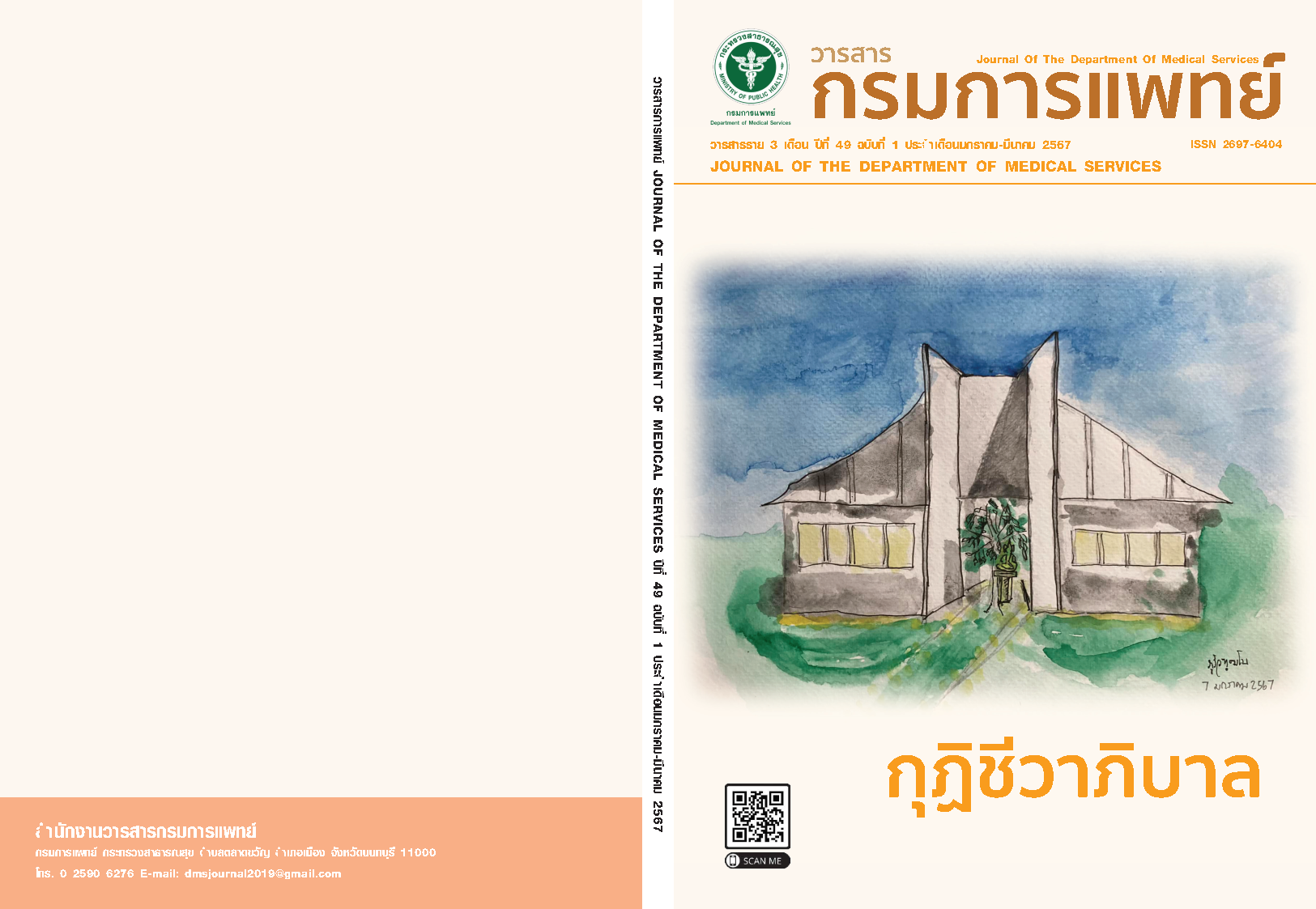Clinical Spectrum and Outcome of Idiopathic Inflammatory Myopathy at Neurological Institute of Thailand (NIT)
Keywords:
Immune-mediated necrotizing myopathy, Relapse, OutcomesAbstract
Background: Immune-mediated necrotizing myopathy (IMNM) is a severe inflammatory myopathy with a high relapse rate. Objective: We aimed to compare clinical characteristics, lab data, and treatment outcomes in Thai patients with immune-mediated necrotizing myopathy (IMNM) to other idiopathic inflammatory myopathies (IIMs). Methods: This retrospective study included IIMs patients aged 18 or older, treated at the Neurological Institute of Thailand (NIT) between 2015 and 2021. Patients had relevant clinical and lab data, including muscle enzymes, from a minimum of 3 follow-up visits within a year. Baseline clinical and lab data, including serum myositis-specific and associated autoantibodies (MSAs and MAAs), were documented. Results: Out of 25 IIMs patients, 18 had IMNM (15 anti-SRP, 2 anti-HMGCR, and 1 sero-negative). Five (20%) had dermatomyositis (2 anti-Mi2, 2 anti-NXP2, and 1 anti-1TIF1γ positive), and 2 (8%) had overlap myositis (OM) with anti-KU positive. The mean age of onset was 49±14.3 years, with 72% being female. Median symptom duration was 90 days (IQR, 45-150). The mean initial MRC sumscore for IMNM was 42.68±10.1, and for non-IMNM (DM and OM) it was 44.5±6.6 and 56±2.8, respectively. However, median CK level was significantly higher in IMNM patients compared to non-IMNM (DM and OM) (4952.5 vs. 1,816 U/L, p = .03). Eighty percent received 2 immunosuppressive drugs. Only 3 IMNM and 1 DM needed IVIg or rituximab as rescue therapy. Around 40-50% of patients had full motor strength at 1 year, but 38.9% of IMNM patients experienced relapses. Conclusions: Most patients with IIMs responded well to two immunosuppressive drugs. However, approximately 40% of IMNM experienced relapses and persistent mild hip flexor weakness.
References
Mammen AL, Allenbach Y, Stenzel W, Benveniste O; ENMC 239th Workshop Study Group. 239th ENMC International Workshop: Classification of dermatomyositis, Amsterdam, the Netherlands, 14-16 December 2018. Neuromuscul Disord 2020;30 (1):70-92.
Kassardjian CD, Lennon VA, Alfugham NB, Mahler M, Milone M. Clinical features and treatment outcomes of necrotizing autoimmune myopathy. JAMA Neurol 2015;72(9):996-1003.
Lundberg IE, Tjärnlund A, Bottai M, Werth VP, Pilkington C, de Visser M, et al. 2017 European League Against Rheumatism/American College of Rheumatology Classification Criteria for Adult and Juvenile Idiopathic Inflammatory Myopathies and Their Major Subgroups. Arthritis Rheumatol 2017;69(12): 2271-82.
Hoogendijk JE, Amato AA, Lecky BR, Choy EH, Lundberg IE, Rose MR, et al. 119th ENMC international workshop: trial design in adult idiopathic inflammatory myopathies, with the exception of inclusion body myositis, 10-12 October 2003, Naarden, The Netherlands. Neuromuscul Disord 2004;14(5):337-45.
Mariampillai K, Granger B, Amelin D, Guiguet M, Hachulla E, Maurier F, et al. Development of a new classification system for idiopathic inflammatory myopathies based on clinical manifestations and myositis-specific autoantibodies. JAMA Neurol. 2018;75(12):1528-37.
Allenbach Y, Mammen AL, Benveniste O, Stenzel W; Immune-Mediated Necrotizing Myopathies Working Group. 224th ENMC International Workshop: Clinicosero-pathological classification of immune-mediated necrotizing myopathies Zandvoort, The Netherlands, 14-16 October 2016. Neuromuscul Disord 2018;28(1): 87-99.
Turan Z, Topaloglu M, Ozyemisci Taskiran O. Medical research council-sumscore: a tool for evaluating muscle weakness in patients with post-intensive care syndrome. Crit Care 2020;24(1):562.
Yongchairat K, Tanboon J, Waisayarat J, Narongroeknawin P, Chevaisrakul P, Dejthevaporn C, et al. Clinical spectrums and outcomes of necrotizing autoimmune myopathy versus other idiopathic inflammatory myopathies: a multicenter case-control study. Clin Rheumatol 2019;38(12):3459-69.
Watanabe Y, Uruha A, Suzuki S, Nakahara J, Hamanaka K, Takayama K, et al. Clinical features and prognosis in anti-SRP and anti-HMGCR necrotising myopathy. J Neurol Neurosurg Psychiatry 2016;87(10):1038-44.
Ashton C, Junckerstorff R, Bundell C, Hollingsworth P, Needham M. Treatment and outcomes in necrotising autoimmune myopathy: an Australian perspective. Neuromuscul Disord 2016;26(11):734-40.
Suzuki S, Nishikawa A, Kuwana M, Nishimura H, Watanabe Y, Nakahara J, et al. Inflammatory myopathy with anti-signal recognition particle antibodies: case series of 100 patients. Orphanet J Rare Dis 2015;10:61.
Rigolet A, Musset L, Dubourg O, Maisonobe T, Grenier P, Charuel JL, et al. Inflammatory myopathies with anti-Ku antibodies: a prognosis dependent on associated lung disease. Medicine 2012;91(2):95-102.
Dalakas MC. Polymyositis, dermatomyositis and inclusion-body myositis. N Engl J Med 1991;325(21):1487-98.
Tanboon J, Nishino I. Classification of idiopathic inflammatory myopathies: pathology perspectives. Curr Opin Neurol. 2019;32(5):704-14.
De Souza JM, Hoff LS, Shinjo SK. Intravenous human immunoglobulin and/or methylprednisolone pulse therapies as a possible treat-to-target strategy in immune-mediated necrotizing myopathies. Rheumatol Int 2019;39(7):1201-12.
Landon-Cardinal O, Allenbach Y, Soulages A, Rigolet A, Hervier B, Champtiaux N, et al. Rituximab in the treatment of refractory Anti-HMGCR immune-mediated necrotizing myopathy. J Rheumatol 2019;46(6):623-7.
Downloads
Published
How to Cite
Issue
Section
License
Copyright (c) 2024 Department of Medical Services, Ministry of Public Health

This work is licensed under a Creative Commons Attribution-NonCommercial-NoDerivatives 4.0 International License.
บทความที่ได้รับการตีพิมพ์เป็นลิขสิทธิ์ของกรมการแพทย์ กระทรวงสาธารณสุข
ข้อความและข้อคิดเห็นต่างๆ เป็นของผู้เขียนบทความ ไม่ใช่ความเห็นของกองบรรณาธิการหรือของวารสารกรมการแพทย์



